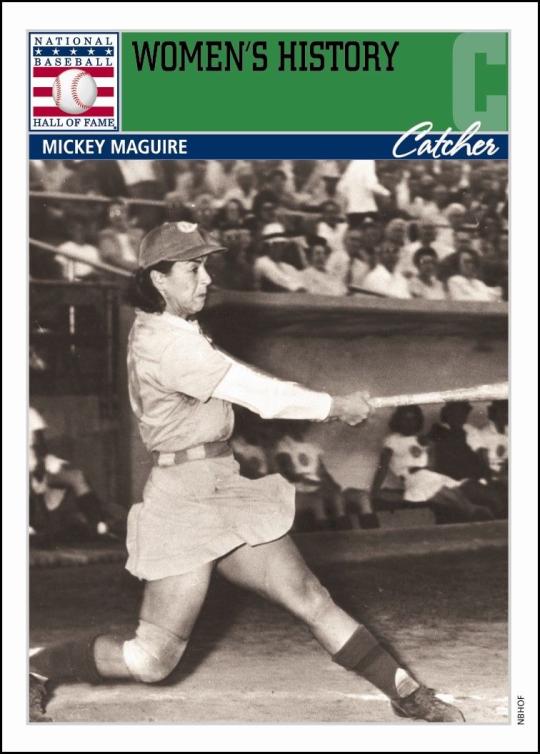Lesson 1: Women's History (Advanced)
Lesson
1. To begin this lesson, have students respond to the following prompt: “What makes a person qualified to be a sports executive? Why do you think that historically there have been fewer female sports executives than male executives? Do you think that might be changing? Why or why not?”
2. Allow students a few minutes to write, and then ask them to share their responses with the class. Ask students if they can name one current female sports executive.
3. Explain that baseball has often been viewed as a “boys’ club,” but there have been women who have reached high levels of management and ownership in professional baseball. Students will be examining short biographies of four different women who have made an impact on the national pastime.
4. Provide each student with a copy of one of the four “Diamond Dreams” profiles included with this lesson:
• Helene Britton
• Effa Manley
• Judy Scarafile
• Linda Alvarado
5. Students should read each profile carefully and respond to the following questions as a note-taking exercise:
• During what years did this person’s career take place?
• What was/is this woman's role in baseball?
• What was/is her background (education or training)?
• How did this executive become interested in working in professional baseball?
• What obstacles, if any, did this person overcome?
6. Once students have finished working, have students with the same profiles gather in small groups to review their notes.
7. Introduce the activity.
Activity
1. Go to your school’s library or media center during your scheduled time slot.
2. During this class period, each group should conduct additional research on their profile subject using print and Internet resources.
3. Students are expected to take notes and keep a list of sources they reference for research.
4. Based on their research, each group will put together a three to five minute oral presentation about their female executive. To supplement their presentations, they may use images or slideshow software.
5. Additionally, each student must turn in his or her own bibliography reflecting properly cited sources used for their presentations.
Conclusion:
To conclude this lesson and check for understanding, have students address the following question in a journal response: Why are women still a minority in baseball's front offices? What would have to happen for women to achieve equality in executive roles?
Common Core Standards
RI.9-10.1. Cite strong and thorough textual evidence to support analysis of what the text says explicitly as well as inferences drawn from the text.
RI.9-10.2. Determine a central idea of a text and analyze its development over the course of the text, including how it emerges and is shaped and refined by specific details; provide an objective summary of the text.
RI.9-10.3. Analyze how the author unfolds an analysis or series of ideas or events, including the order in which the points are made, how they are introduced and developed, and the connections that are drawn between them.
RI.9-10.4. Determine the meaning of words and phrases as they are used in a text, including figurative, connotative, and technical meanings; analyze the cumulative impact of specific word choices on meaning and tone.
RI.11-12.1. Cite strong and thorough textual evidence to support analysis of what the text says explicitly as well as inferences drawn from the text, including determining where the text leaves matters uncertain.
RI.11-12.2. Determine two or more central ideas of a text and analyze their development over the course of the text, including how they interact and build on one another to provide a complex analysis; provide an objective summary of the text.
RI.11-12.3. Analyze a complex set of ideas or sequence of events and explain how specific individuals, ideas, or events interact and develop over the course of the text.
RI.11-12.4. Determine the meaning of words and phrases as they are used in a text, including figurative, connotative, and technical meanings; analyze how an author uses and refines the meaning of a key term or terms over the course of a text.
W.9-10.7., W.11-12.7. Conduct short as well as more sustained research projects to answer a question (including a self-generated question) or solve a problem; narrow or broaden the inquiry when appropriate; synthesize multiple sources on the subject, demonstrating understanding of the subject under investigation.
W.9-10.8., W.11-12.8. Gather relevant information from multiple authoritative print and digital sources, using advanced searches effectively; assess the usefulness of each source in answering the research question; integrate information into the text selectively to maintain the flow of ideas, avoiding plagiarism and following a standard format for citation.
W.9-10.9., W.11-12.9. Draw evidence from literary or informational texts to support analysis, reflection, and research.
SL.9-10.1., SL.11-12.1. Initiate and participate effectively in a range of collaborative discussions (one-on-one, in groups, and teacher-led) with diverse partners on grade-appropriate topics, texts, and issues, building on others’ ideas and expressing their own clearly and persuasively.
SL.9-10.2., SL.11-12.2. Integrate multiple sources of information presented in diverse media or formats (e.g., visually, quantitatively, orally) evaluating the credibility and accuracy of each source.
SL.9-10.4., SL.11-12.4. Present information, findings, and supporting evidence clearly, concisely, and logically such that listeners can follow the line of reasoning and the organization, development, substance, and style are appropriate to purpose, audience, and task.
SL.9-10.5., SL.11-12.5. Make strategic use of digital media (e.g., textual, graphical, audio, visual, and interactive elements) in presentations to enhance understanding of findings, reasoning, and evidence and to add interest.

